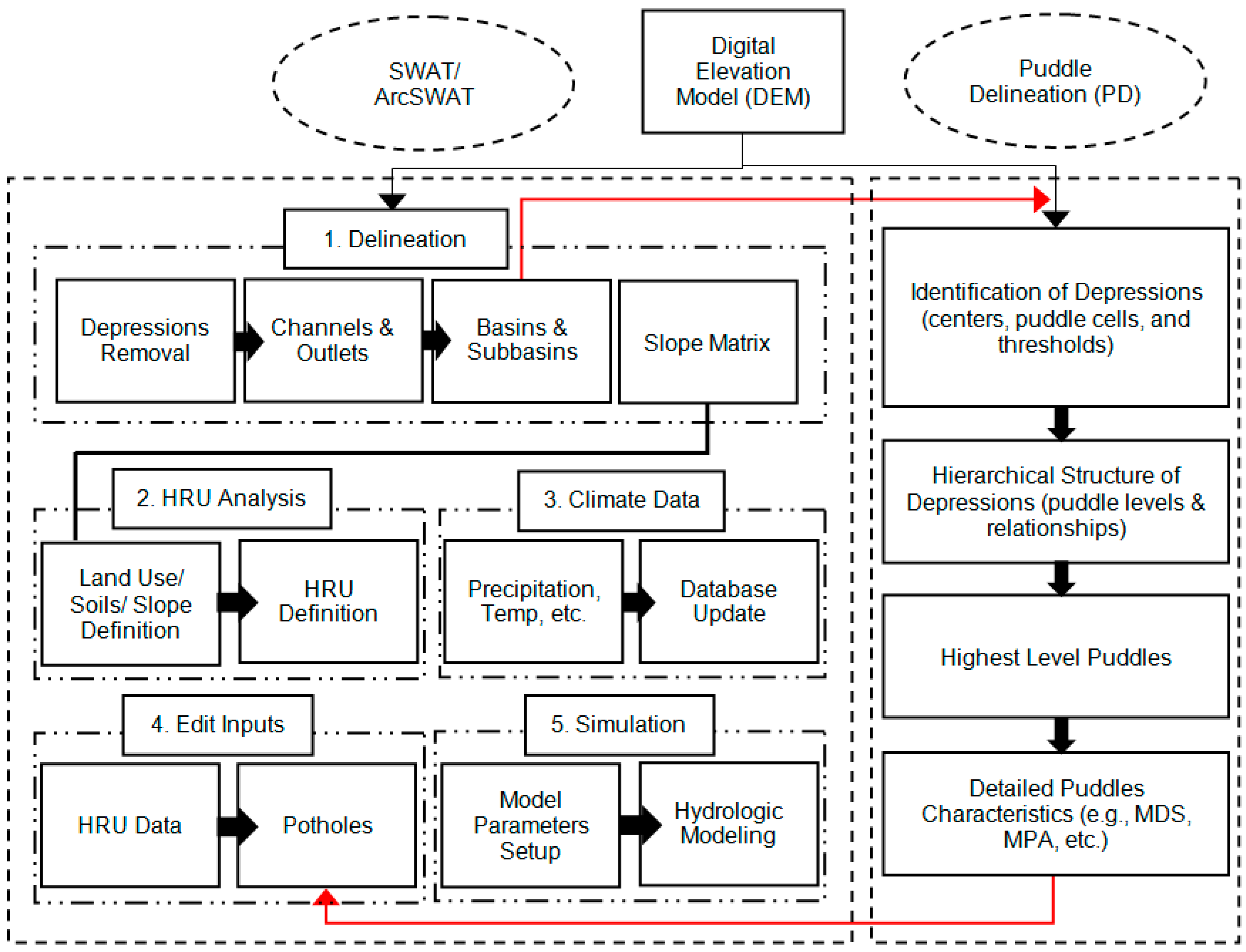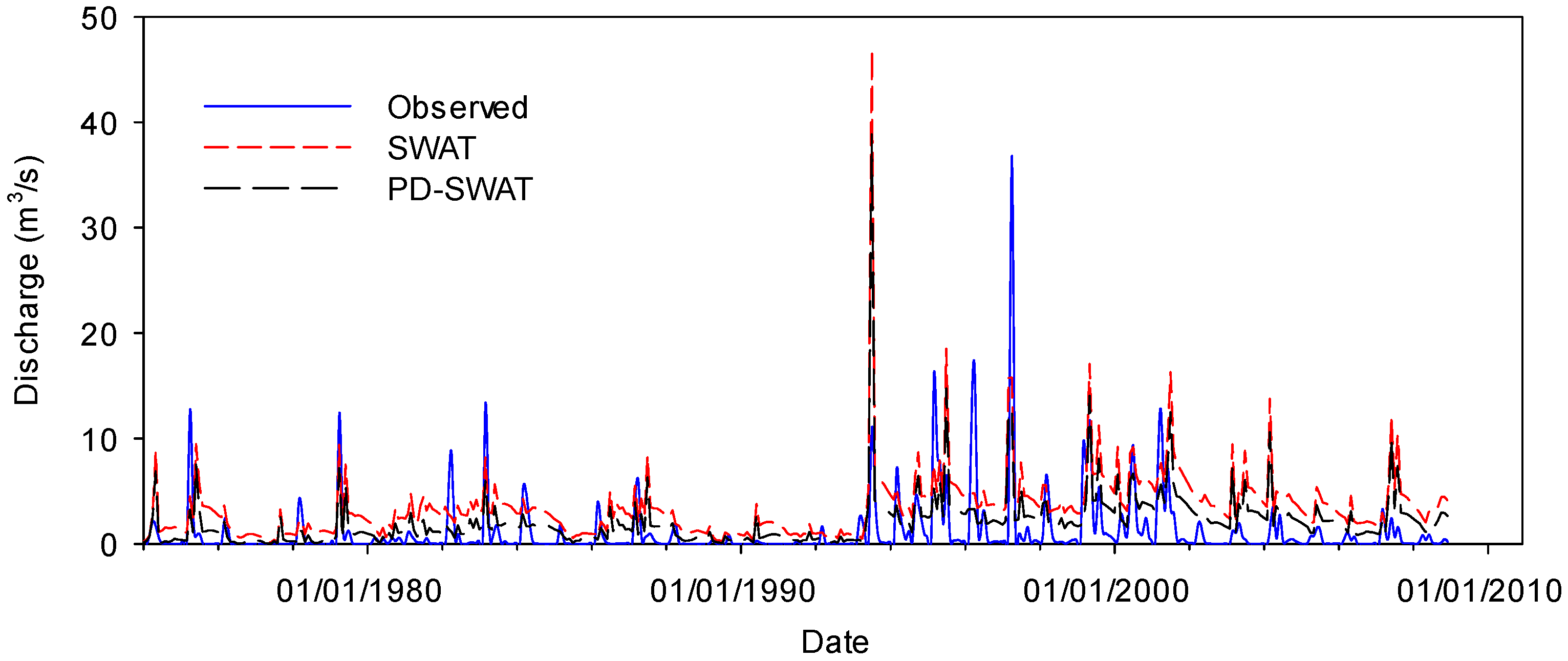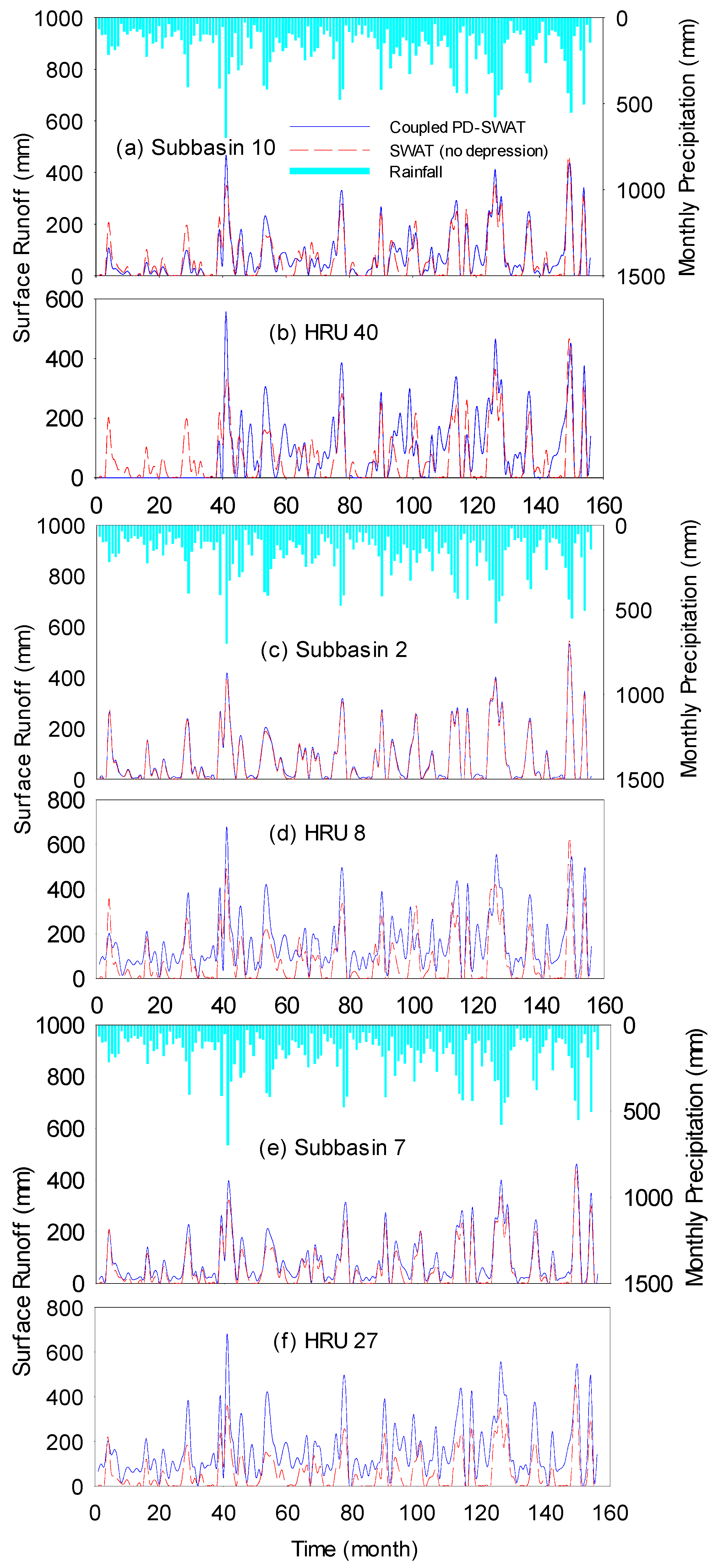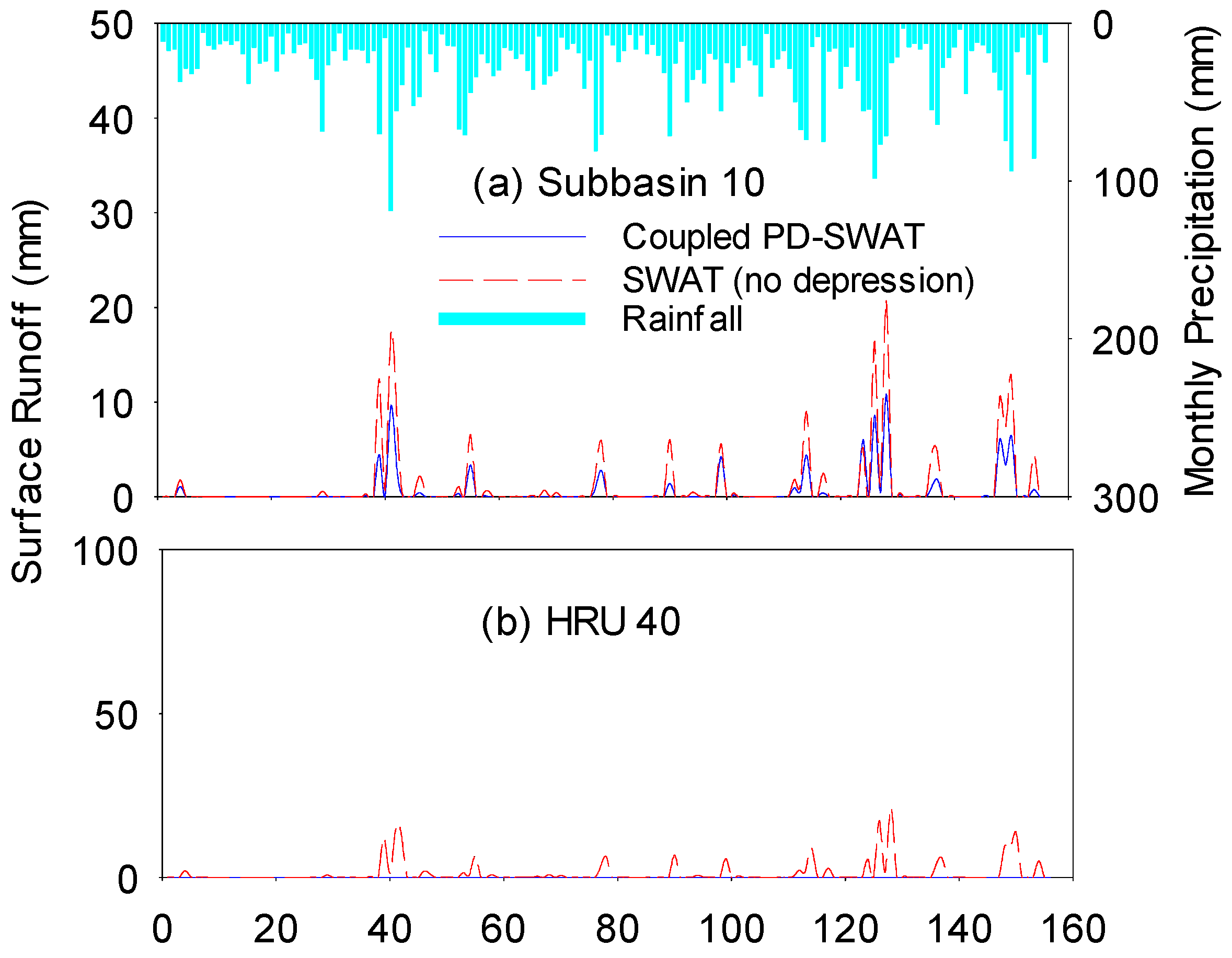SWAT Modeling for Depression-Dominated Areas: How Do Depressions Manipulate Hydrologic Modeling?
Abstract
:1. Introduction
2. Materials and Methods
2.1. Introduction to the PD Algorithm: How to Consider Real Topographic Depressions
2.2. Coupled PD-SWAT Model
2.3. Testing of the Coupled PD-SWAT Model and Preparation of Input Data
3. Results
3.1. Depression Characteristics
3.1.1. Delineation Results for the Large Watershed
3.1.2. Delineation Results for the Small Site
3.2. Threshold-Control Function of Depressions: Depressions as Gatekeepers
4. Conclusions
Acknowledgments
Author Contributions
Conflicts of Interest
References
- Euliss, N.H., Jr.; Mushet, D.M.; Wrubleski, D.A. Invertebrates in Freshwater Wetlands of North America: Ecology and Management. In Wetlands of the Prairie Pothole Region: Invertebrate Species Composition, Ecology, and Management; Batzer, D.P., Rader, R.B., Wissinger, S.A., Eds.; John Wiley and Sons: New York, NY, USA, 1999; pp. 471–514. [Google Scholar]
- Mekonnen, B.; Mazurek, K.; Putz, G. Sediment Export Modeling in Cold-Climate Prairie Watersheds. J. Hydrol. Eng. 2016, 21, 05016005. [Google Scholar] [CrossRef]
- Ullah, W.; Dickinson, W.T. Quantitative description of depression storage using a digital surface model. II Characteristics of surface depressions. J. Hydrol. 1979, 42, 77–90. [Google Scholar] [CrossRef]
- Abedini, M.J. On Depression Storage, Its Modelling and Scale. Ph.D. Thesis, Department of Water Resources Engineering, University of Guelph, Guelph, ON, Canada, 1998. [Google Scholar]
- Chu, X.; Zhang, J.; Chi, Y.; Yang, J. An improved method for watershed delineation and computation of surface depression storage. In Watershed Management Conference 2010; Potter, K.W., Frevert, D.K., Eds.; American Society of Civil Engineers (ASCE): Reston, VA, USA, 2010; pp. 1113–1122. [Google Scholar]
- Chu, X.; Yang, J.; Chi, Y.; Zhang, J. Dynamic puddle delineation and modeling of puddle-to-puddle filling-spilling-merging-splitting overland flow processes. Water Resour. Res. 2013, 49, 3825–3829. [Google Scholar] [CrossRef]
- Chu, X. Delineation of Pothole-Dominated Wetlands and Modeling of Their Threshold Behaviors. J. Hydrol. Eng. 2015, 22. [Google Scholar] [CrossRef]
- Mekonnen, B.A.; Mazurek, K.A.; Putz, G. Incorporating landscape depression heterogeneity into the Soil and Water Assessment Tool (SWAT) using a probability distribution. Hydrol. Process. 2016, 30, 2373–2389. [Google Scholar] [CrossRef]
- Habtezion, N.; Nasab, M.T.; Chu, X. How does DEM resolution affect microtopographic characteristics, hydrologic connectivity, and modeling of hydrologic processes? Hydrol. Process. 2016, 30, 4870–4892. [Google Scholar] [CrossRef]
- Arnold, J.G.; Allen, P.M.; Bernhardt, G. A comprehensive surface-groundwater flow model. J. Hydrol. 1993, 142, 47–69. [Google Scholar] [CrossRef]
- Arnold, G.J.; Srinivasan, R.; Muttiah, R.S.; Williams, J.R. Large area hydrologic modeling and assessment Part I: Model development. J. Am. Water Resour. Assoc. 1998, 34, 73–89. [Google Scholar] [CrossRef]
- Gassman, P.W.; Reyes, M.R.; Green, C.H.; Arnold, J.G. The soil and water assessment tool: Historical development, applications, and future research directions. Trans. ASABE 2007, 50, 1211–1250. [Google Scholar] [CrossRef]
- Krysanova, V.; Arnold, J.G. Advances in ecohydrological modelling with SWAT—A review. Hydrol. Sci. J. 2008, 53, 939–947. [Google Scholar] [CrossRef]
- Qiao, L.; Zou, C.B.; Will, R.E.; Stebler, E. Calibration of SWAT model for woody plant encroachment using paired experimental watershed data. J. Hydrol. 2015, 523, 231–239. [Google Scholar] [CrossRef]
- Soil and Water Assessment Tool (SWAT). Available online: http://swat.tamu.edu/software/arcswat/ (accessed on 8 December 2016).
- Sophocleous, M.A.; Koelliker, J.K.; Govindaraju, R.S.; Birdie, T.; Ramireddygari, S.R.; Perkins, S.P. Integrated numerical modeling for basin-wide water management: The case of the Rattlesnake Creek basin in south-central Kansas. J. Hydrol. 1999, 214, 179–196. [Google Scholar] [CrossRef]
- Shrestha, R.R.; Dibike, Y.B.; Prowse, T.D. Modeling climate change impacts on hydrology and nutrient loading in the upper assiniboine catchment. J. Am. Water Resour. Assoc. 2011, 48, 74–89. [Google Scholar] [CrossRef]
- Yactayo, G.A. Modification of the SWAT Model to Simulate Hydrologic Processes in a Karst-Influenced Watershed. Master’s Thesis, Virginia Polytechnic Institute and State University, Virginia, VA, USA, 2009. [Google Scholar]
- Environmental Systems Research Institute (ESRI). Arc Hydro Tools—Tutorial, version 2.0; Environmental Systems Research Institute: Redlands, CA, USA, 2011. [Google Scholar]
- Almendinger, J.E.; Murphy, M.S.; Ulrich, J.S. Use of the soil and water assessment tool to scale sediment delivery from field to watershed in an agricultural landscape with topographic depressions. J. Environ. Qual. 2014, 43, 9–17. [Google Scholar] [CrossRef] [PubMed]
- Arnold, J.G.; Allen, P.M.; Volk, M.; Williams, J.R.; Bosch, D.D. Assessment of different representations of spatial variability on SWAT model performance. Trans. ASABE 2010, 53, 1433–1443. [Google Scholar] [CrossRef]
- Evenson, G.R.; Golden, H.E.; Lane, C.R.; D’Amico, E. Geographically isolated wetlands and watershed hydrology: A modified model analysis. J. Hydrol. 2015, 529, 240–256. [Google Scholar] [CrossRef]
- Neitsch, S.L.; Williams, J.R.; Arnold, J.G.; Kiniry, J.R. Soil and Water Assessment Tool Theoretical Documentation Version 2009; Texas Water Resources Institute: College Station, TX, USA, 2011. [Google Scholar]
- Du, B.; Arnold, J.G.; Saleh, A.; Jaynes, D.B. Development and application of SWAT to landscapes with tiles and potholes. Trans. ASAE 2005, 48, 1121–1133. [Google Scholar] [CrossRef]
- Evenson, G.R.; Golden, H.E.; Lane, C.R.; D’Amico, E. An improved representation of geographically isolated wetlands in a watershed-scale hydrologic model. Hydrol. Process. 2016, in press. [Google Scholar]
- Global Weather Data for SWAT. Available online: http://globalweather.tamu.edu/ (accessed on 8 December 2016).
- Yang, J.; Chu, X. A new modeling approach for simulating microtopography-dominated, discontinuous overland flow on infiltrating surfaces. Adv. Water Resour. 2015, 78, 80–93. [Google Scholar] [CrossRef]








| Rank | Parameters | Calibration Details | Sensitivity Analysis | |||
|---|---|---|---|---|---|---|
| Fitted_Value | Min_Value | Max_Value | t-Stat | p-Value | ||
| 1 | CN2 | 75.000 | 40.0 | 92.0 | −25.540 | 0.000 |
| 2 | ALPHA_BF | 0.369 | 0.0 | 0.5 | −0.799 | 0.638 |
| 3 | GW_DELAY | 52.000 | 30.0 | 450.0 | −2.148 | 0.033 |
| 4 | GWQMN | 0.785 | 0.0 | 2.0 | −1.298 | 0.195 |
| 5 | GW_REVAP | 0.007 | 0.0 | 0.2 | 2.110 | 0.035 |
| 6 | ESCO | 0.873 | 0.5 | 0.9 | 0.470 | 0.638 |
| 7 | SFTMP | −4.925 | −5.0 | 5.0 | 0.161 | 0.871 |
| 8 | SOL_AWC | 0.230 | 0.0 | 2.0 | 0.946 | 0.345 |
| 9 | SOL_K | 4.500 | 0.0 | 1500.0 | −2.147 | 0.033 |
| 10 | SOL_BD | 1.250 | 0.0 | 10.0 | −1.368 | 0.172 |
| Depression Category | Number of Depressions | Sum of Maximum Depression Storages (m3) | Sum of Maximum Ponding Areas (m2) | Mean Depth of Depressions (m) | Storage Capacity of the Largest Depression (m3) |
|---|---|---|---|---|---|
| 5 cm ≤ MD < 2 m | 2170 | 1.115 × 108 | 1.268 × 108 | 0.89 | 3.1 × 106 |
| MD ≥ 2 m | 71 | 2.764 × 108 | 7.92 × 107 | 3.48 | 5.57 × 107 |
| Sub-Basin | Sub-Basin Area (m2) | Number of Depressions | Maximum Depression Storage (m3) | Maximum Ponding Area (m2) | Storage Capacity of the Largest Depression (m3) |
|---|---|---|---|---|---|
| 10 | 1,647,200 | 11 | 2,819,289 | 594,600 | 2,814,711 |
| 7 | 784,800 | 19 | 37,186 | 74,000 | 12,147 |
| 2 | 291,700 | 12 | 4195 | 10,100 | 4082 |
© 2017 by the authors; licensee MDPI, Basel, Switzerland. This article is an open access article distributed under the terms and conditions of the Creative Commons Attribution (CC-BY) license (http://creativecommons.org/licenses/by/4.0/).
Share and Cite
Tahmasebi Nasab, M.; Singh, V.; Chu, X. SWAT Modeling for Depression-Dominated Areas: How Do Depressions Manipulate Hydrologic Modeling? Water 2017, 9, 58. https://doi.org/10.3390/w9010058
Tahmasebi Nasab M, Singh V, Chu X. SWAT Modeling for Depression-Dominated Areas: How Do Depressions Manipulate Hydrologic Modeling? Water. 2017; 9(1):58. https://doi.org/10.3390/w9010058
Chicago/Turabian StyleTahmasebi Nasab, Mohsen, Vishal Singh, and Xuefeng Chu. 2017. "SWAT Modeling for Depression-Dominated Areas: How Do Depressions Manipulate Hydrologic Modeling?" Water 9, no. 1: 58. https://doi.org/10.3390/w9010058






